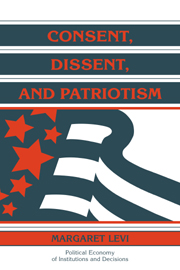Book contents
- Frontmatter
- Contents
- Series editors' preface
- Acknowledgments
- 1 HISTORY AS POLITICS
- 2 THE CONTINGENCIES OF CONSENT
- 3 GONE FOR A SOLDIER
- 4 THE PRICE OF CITIZENSHIP
- 5 THE INSTITUTION OF CONSCRIPTION
- 6 GIVING AND REFUSING CONSENT: CITIZEN RESPONSE IN THE CANADIAN CONSCRIPTION CRISES
- 7 A WEAPON AGAINST WAR: CONSCIENTIOUS OBJECTION IN THE UNITED STATES, AUSTRALIA, AND FRANCE
- 8 THE DEMOCRATIZATION OF COMPLIANCE
- Bibliography
- Index
- Titles in the series
7 - A WEAPON AGAINST WAR: CONSCIENTIOUS OBJECTION IN THE UNITED STATES, AUSTRALIA, AND FRANCE
Published online by Cambridge University Press: 10 December 2009
- Frontmatter
- Contents
- Series editors' preface
- Acknowledgments
- 1 HISTORY AS POLITICS
- 2 THE CONTINGENCIES OF CONSENT
- 3 GONE FOR A SOLDIER
- 4 THE PRICE OF CITIZENSHIP
- 5 THE INSTITUTION OF CONSCRIPTION
- 6 GIVING AND REFUSING CONSENT: CITIZEN RESPONSE IN THE CANADIAN CONSCRIPTION CRISES
- 7 A WEAPON AGAINST WAR: CONSCIENTIOUS OBJECTION IN THE UNITED STATES, AUSTRALIA, AND FRANCE
- 8 THE DEMOCRATIZATION OF COMPLIANCE
- Bibliography
- Index
- Titles in the series
Summary
What I have to do is to see, at any rate, that I do not lend myself to the wrong which I condemn.
Henry David Thoreau, “Civil Disobedience”His disciples went to visit Rabban Yochanan ben Zakkai as he lay ill. They said: “Master, give us your blessing.” He replied: “May you fear God as much as you fear human beings.” They said: “No more than that?” He replied: “That is more than enough, believe me! Do you not know that when we are about to commit a transgression we dismiss God from our minds and hope that no human eye may notice us!”
Talmud (quoted in Gates of Repentance: 231)Conscientious objection is a weapon of protest. It is not, however, a collective protest. It is an individual, but socially informed, act of resistance. It requires no organization, no mobilization of others, no group process. It is an action undertaken by single individuals albeit, generally, individuals who are part of self-conscious groups of war protesters.
Conscientious objection bears an obvious family resemblance to civil disobedience. Where it differs is that it has become a legal act of resistance. It was not always, so, however. Historically the term referred to opposition to war and conscription on grounds of conscience whether one consequently received a legal exemption from military service or whether one resisted the law by refusing to be conscripted.
- Type
- Chapter
- Information
- Consent, Dissent, and Patriotism , pp. 165 - 199Publisher: Cambridge University PressPrint publication year: 1997



